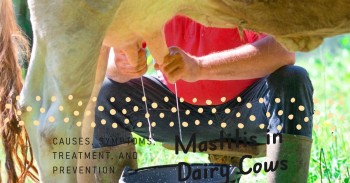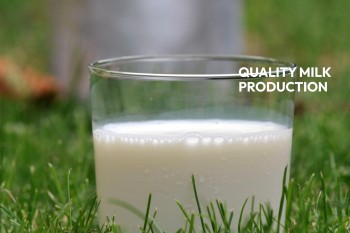🐄 Understanding Livestock Diseases: A
Comprehensive Guide 🐖
Raising livestock like cattle, pigs, sheep, and
goats is an integral part of many farming operations. However, livestock are
susceptible to various diseases that can impact animal health and farm
productivity. As a livestock owner or farmer, it's important to understand the
common diseases that may affect your animals and how to prevent, manage, and
treat them. This comprehensive guide covers the major livestock diseases you
need to know about.
Cattle Diseases
Cattle can be affected by both infectious
diseases caused by pathogens and metabolic diseases related to nutrition and
management. Here are some of the most important cattle diseases to understand:
Bovine Viral Diarrhea (BVD)
🤧 BVD is an infectious gastrointestinal
disease caused by a pestivirus. It spreads through contact with infected cattle
or contaminated materials. The symptoms include diarrhea, fever, runny nose,
coughing, and ulcers in the mouth. BVD can also cause reproductive issues like
infertility, abortions, and birth defects. Prevent BVD by quarantining and
testing new cattle, maintaining a closed herd, and vaccinating. There is no
treatment, but supportive care can help affected cattle recover.
Bovine Respiratory Disease (BRD)
😷 BRD, also known as shipping fever, causes pneumonia in cattle. It is
most common in stressed cattle after transport or entry into a feedlot. Viral
and bacterial infections, like bovine herpesvirus, parainfluenza virus,
Pasteurella bacteria, and Mycoplasma bacteria, can all contribute to BRD.
Symptoms include fever, coughing, nasal discharge, rapid breathing, and
lethargy. Preventive measures include reducing stress, proper ventilation,
antibiotics, and vaccination. BRD is treated with antibiotics,
anti-inflammatories, and supportive care.
Johne's Disease
🤢 Johne's disease is a contagious
bacterial infection caused by Mycobacterium avium paratuberculosis. It attacks
the intestines, leading to chronic diarrhea and weight loss. The bacteria spreads
through manure, colostrum, milk, or utero from mother to calf. Testing blood,
manure, or tissues are required for diagnosis. Johne's is managed by
quarantine, culling infected cattle, and keeping susceptible calves separate
from adults. There is no cure, but vaccines can help control the spread.
Mastitis
🥛 Mastitis is the inflammation of the
mammary gland and udder tissue. It usually occurs as a bacterial infection in
dairy cattle around calving or during lactation. Symptoms include swelling,
pain, redness, and abnormal milk. Mastitis is treated with antibiotics. Prevent
it by maintaining hygienic facilities, properly milking cows, and dipping teats
in disinfectant.
Pinkeye
😵💫 Infectious bovine keratoconjunctivitis, also known as pinkeye, causes
ocular swelling, irritation, and ulcers. Face flies can spread the bacteria
that cause pinkeye between cattle. Symptoms include excessive tearing,
squinting, and blindness if untreated. Pinkeye is treated with eye ointments,
antibiotics, and anti-inflammatories. Prevent it by controlling flies, avoiding
irritation, and vaccination.
Foot Rot
🦶 Foot rot is a highly contagious
bacterial infection between the toes of cattle causing lameness. The bacteria
Fusobacterium necrophorum and Dichelobacter nodosus infects the skin and
progresses to swelling, wounds, and rotting tissue. It spreads via pastures,
stalls, and hoof trimming equipment. Treat foot rot with antibiotics, foot
baths, and bandages. Culling chronically infected cattle may be necessary.
Hardware Disease
🥄 Hardware disease occurs when cattle
ingest sharp metal objects like nails, wires, and machinery parts while grazing
or eating feed. These objects can lodge in the stomach or intestines, causing
pain, infection, and potentiallydeath. Prevent hardware disease by keeping
pastures and feed sources free of metal. Surgery may be needed to remove
ingested metal objects.
Swine Diseases
Pigs can suffer from various bacterial, viral,
and parasitic illnesses. Here are important swine diseases to know:
Porcine Reproductive and Respiratory Syndrome (PRRS)
😷 PRRS is a viral disease that impacts reproduction in breeding pigs and
causes respiratory illness in young pigs. Symptoms include late-term abortions,
stillbirths, weak piglets, and respiratory distress. The virus spreads through
direct contact and aerosols. All ages of pigs are susceptible, but the disease
primarily affects nursery to finisher pigs. Vaccination, herd closure, and
quarantine help control PRRS. Supportive care for sick pigs may be needed.
Swine Influenza
🤒 Swine influenza is caused by type A
influenza viruses. Pigs can be infected with avian, human, and swine influenza
strains. Symptoms include fever, lethargy, runny nose, coughing, and difficulty
breathing. Influenza spreads rapidly through herds via aerosols, direct
contact, and contaminated objects. Antiviral drugs, vaccines, and biosecurity
measures help control influenza outbreaks. Good ventilation is also important.
Porcine Epidemic Diarrhea virus (PEDv)
🤢 PEDv is an infectious gastrointestinal
coronavirus. It is highly contagious and potentially fatal to young piglets,
causing severe enteritis, vomiting, and watery diarrhea leading to dehydration
and death. Older pigs may show milder symptoms. PEDv spreads via the fecal-oral
route. Strict biosecurity and sanitation are crucial, as the virus can live for
weeks on surfaces and equipment. Sows can be vaccinated to provide passive
immunity to nursing piglets.
Pleuropneumonia
😷 Pleuropneumonia is a severe respiratory disease caused by the bacteria
Actinobacillus pleuropneumoniae. It spreads through direct contact and
aerosolized droplets. Symptoms include high fever, breathing problems,
coughing, lethargy, and death. It can affect pigs of any age. Antibiotics,
antimicrobials, and vaccines are used to treat and prevent pleuropneumonia.
Proper ventilation is key to control.
Internal Parasites
🪱 Pigs can be infected by several
internal parasites like roundworms, liver flukes, whipworms, and tapeworms.
Larvae and eggs are shed in the manure and spread through contaminated food or
soil. Symptoms include rough hair coats, stunted growth, anemia, diarrhea, and
coughing. Anthelmintic dewormers are used to treat and control worm burdens.
Good sanitation and rotating pastures help break parasite life cycles.
Erysipelas
🤕Erysipelas is caused by the bacterium
Erysipelothrix rhusiopathiae. It manifests as diamond skin lesions, fever,
Depression, Lameness and potentially leads to sudden death. It spreads through
infected soil, feces or animals. Erysipelas is treated with antibiotics and
antimicrobials. Vaccines are available to help prevent infection and control
outbreaks.
Leptospirosis
😵 Leptospirosis is a zoonotic bacterial disease that can spread from pigs
to humans. Pigs become infected through contact with contaminated urine or
soil. It causes fever, jaundice, vomiting, diarrhea, and respiratory illness in
pigs. Piglets can die quickly without treatment. Antibiotics can be used to
treat sick pigs. Vaccines and biosecurity help control leptospirosis on farms.
Sheep and Goat Diseases
Sheep and goats share many common diseases,
though some illnesses affect one species more than the other. Here are
important small ruminant diseases:
Scrapie
🧟 Scrapie is a fatal, degenerative prion
disease that affects the central nervous system of sheep and goats. It is
related to mad cow disease but not contagious to humans. Scrapie causes changes
in behavior, itching, weight loss, trembling, and loss of coordination in
infected animals. It spreads most often from ewe to lamb. There is no treatment
or vaccine. Scrapie can be controlled through genetic selection and herd monitoring
programs.
Caprine Arthritis Encephalitis Virus (CAEV)
🤕 CAEV is a retrovirus that infects
goats causing arthritis, mastitis, pneumonia, and brain inflammation. Kids
infected with CAEV may not show symptoms for years. CAEV spreads through
infected colostrum and milk. Blood testing identifies infected goats that
should be separated or culled. Disinfecting equipment also helps control viral
spread. There is no treatment, but vaccines can help prevent infection.
Caseous Lymphadenitis (CL)
🤢 CL primarily affects sheep and goats
and causes abscesses in lymph nodes and internal organs. Corynebacterium
pseudotuberculosis bacteria spreads through discharges from burst abscesses
contaminating feed, bedding, shearing equipment, etc. Symptoms include external
and internal abscesses, weight loss, lethargy, and poor wool or milk quality.
CL is difficult to treat and control. Vaccines provide partial protection.
Foot Rot
🦶 Foot rot affects sheep and goats
causing lameness and hoof deformation. The bacteria Dichelobacter nodosus
penetrates damaged skin between the toes. It spreads through wet, muddy
conditions. Symptoms include limping, hoof inflammation, and rotten hooves.
Treat foot rot with foot baths, antibiotics, and hoof trimming. Vaccinate high risk
animals and control environmental contamination.
Zoonotic Abortion Diseases
🚫 Several contagious bacterial and protozoan diseases cause abortion in
sheep and goats. Brucella, Chlamydia, Listeria, Salmonella, Toxoplasma, and
Campylobacter species pose risks to humans through contact with birthing
tissues and fluids. Aborted fetuses and placenta should be handled carefully
with gloves. Pregnant women should avoid exposure. Testing identifies infected
animals that abort for culling. Vaccines help prevent some diseases.
Johne's Disease
🤢 Johne's disease also affects sheep and
goats as a chronic gastrointestinal infection. It spreads the Mycobacterium
avium paratuberculosis bacteria through manure contamination. Symptoms develop
slowly and include diarrhea, weight loss, lethargy, and eventual death. Waste
from infected animals contaminates pastures, feed, and water. Control
strategies include herd testing, culling, clean calving areas, and vaccines.
Parasites
🪱 Gastrointestinal parasites like
tapeworms, roundworms, coccidia, and liver flukes plague small ruminants,
especially youngstock. Contaminated soil, food, and water spread the eggs and
larvae. Diarrhea, weight loss, weakness, and bottle jaw indicate parasite
infection. Rotate pastures, avoid overcrowding, remove manure, and use
anthelmintics to control parasites. Dewormers should be rotated to prevent
resistance.
Caseous Lymphadenitis (CLA)
🤢 CLA primarily affects sheep and goats
and causes abscesses in lymph nodes and internal organs. Corynebacterium
pseudotuberculosis bacteria spreads through discharges from burst abscesses
contaminating feed, bedding, shearing equipment, etc. Symptoms include external
and internal abscesses, weight loss, lethargy, and poor wool or milk quality.
CLA is difficult to treat and control. Vaccines provide partial protection.
Preventing Livestock Disease
Preventing livestock disease is critical for
maintaining healthy, productive herds and flocks. Here are some key tips for
disease prevention:
·
Quarantine new arrivals - Isolate new or returning animals before introducing them to the
herd to prevent disease spread.
·
Disinfect properly - Clean and disinfect housing, equipment, and vehicles between
groups. Remove manure, wash, and apply disinfectant.
·
Control pests - Use sprays, bait, traps, and other measures to control flies,
mosquitoes, ticks, and rodents that can transmit diseases.
·
Vaccinate - Consult with your veterinarian to plan an appropriate
vaccination schedule for your region and operation. Vaccines help prevent many
major livestock diseases.
·
Practice biosecurity - Restrict access to your farm, use protective clothing and
footwear, and separate sick animals to avoid spreading diseases.
·
Get diagnostic testing - Work with your veterinarian to routinely collect samples and
test for diseases of concern. Testing allows early detection and intervention.
·
Reduce stress - Minimize transport, crowding, extreme weather, and abrupt diet
changes that stress livestock and weaken immune defenses.
·
Buy from reputable sources - Only bring in livestock from trusted farms with documented
health protocols.
Staying informed about livestock diseases and
being proactive helps create healthier, more productive animals and herds.
Consult your local large animal veterinarian if disease issues arise. With
proper prevention and management, livestock diseases can be effectively
controlled.

















